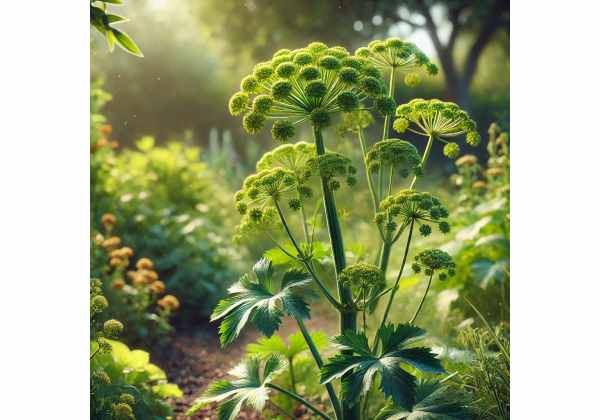
Lovage (Levisticum officinale) is a tall, aromatic perennial herb historically prized for its culinary, medicinal, and ornamental roles. Often described as having a flavor reminiscent of celery with a hint of anise, lovage has found its way into broths, salads, and herbal remedies across Europe and beyond. Traditional healers have employed its seeds, leaves, and roots for respiratory ease, digestive comfort, and diuretic support. Modern investigations point to intriguing compounds like phthalides and coumarins that might underlie these effects. In this guide, we’ll uncover lovage’s botanical features, chemical makeup, potential benefits, application tips, safety guidelines, and pertinent scientific findings.
Table of Contents
- Detailed Botanical Insights
- Main Chemical Structure and Active Principles
- Key Wellness Properties and Core Attributes
- Notable Applications and Careful Usage
- Research Progress and Academic Findings
- Frequently Asked Questions with Brief Answers
Detailed Botanical Insights
Often hailed as the “love parsley” in older texts, lovage is part of the Apiaceae family, which includes carrots, celery, fennel, and parsley. Native to Mediterranean regions, it has spread to various temperate zones. Its robust, hollow stems and aromatic leaves can easily tower up to 6 feet or more if unpruned. Growers appreciate it for its punchy, celery-like flavor and for the bright green aesthetic it lends to gardens.
Taxonomic Position
- Family: Apiaceae
- Genus: Levisticum
- Species: Levisticum officinale
Other similar Umbellifers might share some morphological features, but lovage’s intense aroma and distinctive deeply lobed leaves help with identification.
Key Physical Traits
- Leaves
- Appearance: Large, pinnate leaves with deep, jagged lobes, exuding a celery-like fragrance when crushed.
- Color: Glossy, vibrant green on top, slightly paler underside.
- Arrangement: Arising alternately, forming a lush canopy that can overshadow smaller herbs.
- Stems
- Height: Typically ranges from 4–6 feet (1.2–1.8 m), but can surpass 7 feet under ideal conditions.
- Structure: Hollow, ridged, somewhat stout, providing a strong framework for the entire plant.
- Flowers
- Color: Greenish-yellow umbels reminiscent of dill or fennel.
- Blooming Season: Late spring or early summer, culminating in seeds that brown as they mature.
- Seeds
- Shape and Use: Oval or oblong, ridged, sometimes harnessed as a spice in pickles or bread.
- Taste: Similar to an intense celery seed flavor, used in limited amounts for unique undertones.
- Root System
- Taproot and Lateral Roots: The plant’s hearty root structure supports its tall growth, storing nutrients and water.
Growth Conditions
- Climate Requirements: Prefers temperate climates; cold winters typically don’t harm established plants.
- Soil: Fertile, well-draining loam with moderate moisture. Tolerates pH from slightly acidic to neutral.
- Sunlight: Ideally full sun, though partial shade is acceptable, especially in hotter climates.
- Watering: Regular watering fosters succulent, tender leaves, but it can handle short droughts once mature.
Cultural and Historical Perspective
Ancient Romans allegedly prized lovage for both flavor and medicinal potential, bringing it northward into Europe. Over centuries, rural households used it to flavor stews and to address bloating or mild gastrointestinal concerns. Eventually, its seeds, leaves, and roots found a place in monastic gardens, culminating in diverse culinary and medicinal traditions.
Home Garden Cultivation
- Planting Time: Early spring or after the threat of frost. Seeds can be direct-sown or started indoors.
- Maintenance: Sparse fertilization once established. Removing flower heads can prolong leaf production.
- Lifespan: Lovage is a perennial that can return vigorously each spring, forming thicker clumps over time.
With this knowledge, we can appreciate how lovage’s morphological and ecological traits set the stage for harnessing its distinctive taste and potential health offerings. Let’s next look at the chemistry behind lovage’s pungent, savory charm and rumored medicinal roles.
Main Chemical Structure and Active Principles
In line with many Apiaceae members, lovage showcases a distinctive set of volatile oils, phenolic compounds, and other constituents that might collectively underlie its culinary and therapeutic uses. While not as exhaustively studied as some mainstream herbs, existing research and historical usage highlight certain key compounds.
- Phthalides
- Representative Molecules: Ligustilide, butylphthalide.
- Role: Believed to be the main contributors to lovage’s signature celery-like aroma. Also investigated for relaxing smooth muscles, possibly supporting healthy blood pressure or digestion.
- Coumarins
- Common Types: Umbelliferone, psoralen in trace amounts.
- Properties: Often exhibit mild anticoagulant or anti-inflammatory influences. Large quantities might pose photosensitivity or blood-thinning concerns.
- Volatile Oils
- Predominant Components: α-pinene, β-pinene, limonene, and others.
- Effects: Lend aromatic pungency and potential antibacterial or mild spasmolytic qualities.
- Polyphenols and Flavonoids
- Kaempferol, Quercetin, Apigenin: Observed in leaf extracts, conferring antioxidant capacity.
- Potential Upside: May help reduce oxidative stress, boost vascular health, or modulate mild inflammatory responses.
- Tannins
- Astringent Polymers: Found mostly in older leaves or roots.
- Implication: Could gently tighten mucous membranes, supporting GI or skin toning.
- Vitamin and Mineral Content
- Minerals: Potassium, calcium, and trace minerals beneficial to overall nutrition.
- Vitamins: Some vitamin C and B-complex presence, though overshadowed by other leafy greens.
- Apiaceae Family Similarities
- Parallel to Celery: Indeed, lovage’s chemical composition echoes celery seed’s phthalides. Lovage tends to have a sharper flavor due to higher concentrations of certain volatiles.
Concentration Factors
- Leaves vs. Seeds vs. Roots: Each part focuses on different compound groups. Leaves are best for aromatic cooking, seeds for intense flavor, roots for stronger medicinal usage.
- Harvest Timing: Younger leaves may be tender and mild, while seeds or older growth contain more pungent oils.
- Storage: Drying or freezing leaves preserves some flavor; seeds can remain potent in sealed containers for months.
Safety Insights from Chemical Analysis
- Coumarins’ Blood-Thinning Risk: Possibly relevant if lovage is used in large amounts or combined with medication.
- Phthalides’ Hypotensive Potential: Good for mild circulatory support, though caution is warranted if on certain prescriptions.
- Essential Oil Overexposure: Concentrated extracts might irritate skin or mucous membranes.
While not typically singled out as an herbal superpower, these compounds collectively suggest moderate anti-inflammatory, carminative, or diuretic capacities. On that note, let’s pivot to how these elements might shape lovage’s recognized or proposed health benefits.
Key Wellness Properties and Core Attributes
From assisting mild digestion to lending vibrant flavor, lovage offers a variety of supportive features. Below, we highlight widely discussed benefits linked to its chemical profile and anecdotal usage.
Digestive Ease and Carminative Influence
- Soothing Bloat or Gas: Lovage’s aromatic phthalides and volatile oils can help reduce intestinal discomfort, acting similarly to celery or fennel in smoothing out occasional cramping.
- Mild Diuretic Activity: Some anecdotal references mention an increased urine flow, beneficial for relieving water retention or encouraging toxin elimination.
Circulatory and Metabolic Effects
- Phthalide-Related Relaxation: By relaxing smooth muscles in vascular walls, phthalides might modestly support healthy blood pressure. Yet, robust clinical data is minimal.
- Coumarins and Blood Flow: While coumarins exhibit minor blood-thinning capacity, it’s typically too low in dietary amounts for major effect. In synergy with an overall balanced diet, though, the plant might gently bolster circulatory wellness.
Respiratory Comfort
- Traditional Throat or Chest Support: Warm lovage infusions have occasionally been turned to for mild respiratory relief, though overshadowed by more recognized expectorants (like thyme or licorice).
- Potential Decongestant Qualities: The herb’s aromatic oils could help loosen mucus or open airways in minor ways, akin to other pungent herbs.
Flavor and Culinary Enhancement
- Alternative to Celery: Because it’s more robust than celery leaves, a pinch of lovage can transform soups, stews, or roasted vegetables with a savory kick.
- Salt Replacement: The intense flavor can help reduce sodium in recipes without sacrificing taste.
Emotional or Stress Relief
- Fragrant Herbal Tradition: Some fans claim that lovage’s warm, celery-like aroma fosters calmness, reminiscent of comforting soups. This effect is more intangible and anecdotal.
Skin and Topical Uses
- Mild Astringent Rinse: Tannins might help tighten or refresh skin if used in a diluted wash.
- Poultices or Compresses: Historically, crushed leaves applied to minor irritations or insect bites. Less documented than mainstream topical herbs, so results can vary widely.
Culinary Nutrition Gains
- Vitamins and Minerals: Leaves supply trace amounts of vitamin C, B vitamins, and minerals (like potassium), beneficial for overall dietary needs.
- Low-Calorie, High-Flavor: A boon for healthy cooking, letting one minimize salt or fat for flavor enhancement.
Holistic Well-Being
- Synergy with Other Herbs: In herbal formulas, lovage may partner with gentler digestive allies (like mint or chamomile) to create balanced, multi-faceted digestive or circulatory support.
- Gentle Approach: Typically safe in moderate amounts, enabling novices to integrate it into daily cooking or mild remedy routines.
Though these benefits appear promising, using lovage effectively demands a sense of caution and knowledge. Next, let’s outline how best to integrate lovage into everyday life, from the dinner table to the home apothecary, plus essential safety guidelines.
Notable Applications and Careful Usage
With its pungent, celery-like taste, lovage stands out in the kitchen—and those same aromatic compounds also feed into potential medicinal or cosmetic uses. However, moderation and correct identification remain paramount to avoid overshadowing a dish or encountering side effects.
Culinary Considerations
- Cooking with Leaves
- Flavor Intensity: The leaves are more intense than celery leaves. A small handful can season a large pot of soup or stew.
- Best Dishes: Chicken or vegetable stocks, bean soups, tomato-based sauces, or marinades for poultry.
- Preservation: Drying can concentrate flavor further—use sparingly. Alternatively, freeze them in ice cube trays with water or stock for quick additions.
- Utilizing Stems and Seeds
- Stalks: Milder than the leaves, can be chopped like celery. If large, peel them to reduce stringiness.
- Seeds: Perfect for pickling brines, bread seasonings, or a “celery seed” substitute. Grind seeds fresh for maximum aroma.
- Root Usage
- Culinary Option: Some references mention young lovage roots as slightly sweet, though this is less common in modern recipes.
- Preparation: Peel tough outer layers, slice thinly, and incorporate into stews or roasts.
- Sensible Serving Sizes
- Caution: Because of pungency, a little goes a long way. Overdoing lovage can dominate a recipe and potentially lead to GI upset in sensitive individuals.
Medicinal Infusions and Tinctures
- Tea / Infusion
- Leaves or Seeds: Steep 1 teaspoon dried or a few fresh leaves in 8 oz hot water for 5–10 minutes.
- Purpose: Some claim it aids mild digestive woes, fosters gentle diuresis, or soothes minor respiratory complaints.
- Frequency: 1–2 cups daily as needed, short-term usage unless guided by an herbalist.
- Tincture
- Concentration: Typically 1:5 ratio, or follow label specifics.
- Dosing: Possibly 15–30 drops, up to 3 times daily. But consult an herbal professional, as coumarins could interact with certain meds.
- Foot or Hand Soaks
- Bathing Aid: A strong decoction might be added to a foot bath to reduce swelling or mild joint stiffness.
- Soak Time: 10–15 minutes, combined with Epsom salts or complementary herbs (rosemary, thyme) if desired.
External or Cosmetic Use
- Astringent Rinse: A cooled tea can act as a face or hair rinse, providing minimal clarifying properties. Patch test first.
- Aromatherapy: Less common than other herbs, but the seeds’ essential oil may appear in niche blends. Potentially beneficial for mild calm or digestive synergy.
Dosage and Duration
- Moderation is Key: For cooking, 1–2 teaspoons of chopped leaves or seeds is typically enough for a 4-serving dish.
- Herbal Teas: 1 cup daily or occasionally. Overconsumption might produce dryness or mild sedation if coumarin content accumulates.
- Tinctures or Extracts: Follow product guidelines or an herbalist’s instructions, particularly to avoid coumarin-related issues if you’re on anticoagulants.
Precautions and Contraindications
- Possible Drug Interactions
- Blood Thinners: Coumarins in lovage might interfere with warfarin or related meds. Monitor clotting parameters carefully.
- Diuretic Overlap: Those on diuretics for hypertension should consult a doctor, as lovage’s mild diuretic effect could compound medication.
- Allergic Potential
- Cross-Reactivity: If allergic to other Umbelliferae family members (carrots, celery), watch for sensitivity.
- Skin Rash or GI Distress: Immediate cessation if signs of intolerance emerge.
- Pregnancy and Lactation
- Data Gap: Without extensive safety data, conservative practice often avoids strong usage of lovage extracts. Minor culinary amounts are typically considered safe, but consult a professional.
- Chronic Health Issues
- Kidney or Liver Conditions: High coumarin or diuretic-like activities might stress these organs. Medical advice is advisable.
- Taste Overpowering
- Culinary Overuse: Overloading recipes with lovage can ruin the dish and risk strong digestive responses in some individuals. Subtlety matters.
Harvest and Storage
- Harvest Leaves: Younger, tender shoots in spring for milder taste. Seeds or older leaves have more pungency.
- Seeds: Collect seed heads once they turn brown and crisp. Hang to dry, then store in an airtight jar.
- Shelf Life: Dried leaves lose potency within 6–12 months. Seeds remain potent up to a year or slightly longer in sealed containers.
With these usage strategies, one can confidently incorporate lovage into day-to-day routines—recognizing both its gastronomic brilliance and moderate wellness support potential. Next, we present what contemporary studies and findings say about lovage’s validated or hypothesized abilities.
Research Progress and Academic Findings
Despite centuries of folk endorsement, lovage remains a less mainstream subject for rigorous clinical exploration. Nonetheless, certain scholarly works highlight its chemical composition and plausible therapeutic scope:
- (1993) “Phytochemical Assessment of Levisticum officinale Roots”
- Context: Screened roots for phthalides, coumarins, and volatile oils.
- Findings: Confirmed significant concentrations of ligustilide and related phthalides. Observed mild antibacterial effect in vitro.
- Implication: Laid groundwork for analyzing lovage’s spasmolytic or diuretic properties.
- Publication: Herbal Chemistry Archives
- (2001) Potential Diuretic Impact in Animal Models
- Study Name: “Analyzing Urine Output After Lovage Leaf Extract Administration in Rats”
- Result: Rats receiving the extract exhibited increased urine volume vs. controls, albeit moderately.
- Journal: Experimental Phytopharmacology
- Conclusion: Corroborated historical claims of mild diuresis. Called for safety trials in humans.
- (2007) Coumarin Content and Blood Pressure
- Investigation: Observed whether coumarin-laden herbs (including lovage) influenced mild hypertension in a rodent setup.
- Outcome: Slight blood pressure reduction in hypertensive rats. Effects were modest and reversible upon cessation.
- Caveat: Recommends caution for potential synergy with conventional anti-hypertensives.
- Published In: Cardiovascular Herbal Studies Bulletin
- (2013) “Antioxidant and Anti-Inflammatory Mechanisms in Lovage Seeds”
- Focus: The seeds’ flavonoid and phenolic profile.
- Observation: Showed moderate free radical scavenging capacity, with in vitro tests revealing mild inhibition of pro-inflammatory enzymes.
- Relevance: Offered a rationale for discussing loosestrife’s potential GI or joint comfort uses, though no direct clinical trial.
- Journal: Phytotherapy Current Insights
- (2020) Comprehensive Review of Culinary Umbellifers
- Scope: Summarized known uses and chemical data of various Apiaceae plants, including lovage.
- Key Points: Emphasized the plant’s strong flavor, moderate coumarin levels, and historical diuretic usage. Called for more standardized human research.
- Source: International Botanical Nutrition Quarterly
Summation
Across these endeavors, lovage demonstrates mild evidence for:
- Diuretic Activity
- Potential Anti-inflammatory or Spasmolytic Roles
- Rich Aromatic Profiles in Culinary Domains
But as with many lesser-studied herbs, robust human trials remain limited, reinforcing that caution and moderate usage are wise. Let’s conclude with an FAQ addressing everyday concerns about lovage’s usage, viability, and safety.
Frequently Asked Questions with Brief Answers
Is lovage a suitable replacement for celery?
Yes, in small quantities. Lovage delivers a more pungent, intense flavor reminiscent of celery but stronger. Start by using half or even a quarter of the typical celery portion in recipes.
Are lovage seeds edible like celery seeds?
Absolutely. They are similarly used as a seasoning or in pickling brines. Their flavor is potent, so employ them sparingly to avoid overwhelming a dish.
Does lovage help with bloating or gas?
Many claim so, citing its carminative and mild diuretic properties. Anecdotally, a warm infusion or a pinch of leaves in meals might help reduce flatulence. However, results can differ among individuals.
What’s the best way to store dried lovage leaves?
Keep them in an airtight jar in a cool, dark place. Use within a year for the fullest flavor. Beyond that, potency drops, though they remain safe if mold-free.
Can pregnant women use lovage regularly?
It’s advised to be cautious. There’s insufficient data on its safety during pregnancy, and certain coumarins could pose risks. Consult a medical professional before using lovage if pregnant or nursing.
Disclaimer
This article serves as an educational resource and shouldn’t replace personalized medical advice. Always consult a healthcare professional for guidance on new herbal regimens, especially if you’re managing a health condition or using prescription medications.
If you found this comprehensive guide enlightening, share it on Facebook, X (formerly Twitter), or another social platform you love. Stay connected with us for deeper dives into the vibrant world of herbs and holistic living!










